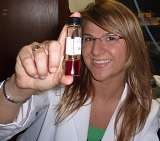Building a better catalyst

(PhysOrg.com) -- An engineering student illuminates the inner workings of vanadium oxide before an audience of biologists and chemists in Japan.
After receiving her bachelor's degree in chemical engineering from Lehigh in 2005, Julie Molinari went to work for a small pharmaceutical company in New Jersey.
Five years later, as a Ph.D. student, she has shown senior researchers around the world something they didn’t know about catalysts.
Molinari presented her research last month at the Seventh International Symposium on the Chemistry and Biology of Vanadium, in Toyama City, Japan. She was one of the few chemical engineers at the conference, which was attended mostly by biologists and chemists.
Molinari uses several spectroscopy techniques to gain a better understanding of vanadium oxide, a catalyst that plays an important role in manufacturing some industrial chemicals and also in reducing nitrogen-oxide emissions from power plants.
“The people at this conference don’t do a lot of optical spectroscopy, so my poster presentation was something different,” says Molinari, who works with Israel Wachs, professor of chemical engineering and director of Lehigh’s Operando Molecular Spectroscopy and Catalysis Research Lab.
“They were excited to find out that it’s possible to visualize molecular bonds under reaction conditions using Raman spectroscopy. Up until now, our research team was basically unknown in the vanadium biocatalysis field. Now they know me as a member of this community and they know my work.”
Finding the corner piece of the puzzle
Molinari’s poster, “Raman, UV-vis and ATR-IR Study of Vanadium Haloperoxidase Enzyme Mimics,” received the third place award at the vanadium conference. UV-vis refers to ultraviolet-visible spectroscopy. ATR—attenuated total reflectance—is a sampling technique used with infrared (IR) spectroscopy.
“Chemical engineers are always seeking to maximize the yield and efficiency of a process,” says Molinari. “In the case of a chemical reaction that requires a catalyst, it’s impossible to optimize the reaction process without knowing how the catalyst works. Understanding the molecular structure of these systems is like having the corner piece of the puzzle.”
In addition to vanadium oxide catalysts, Molinari studies vanadium-containing enzyme mimics with Wachs.
Enzyme mimics are small molecules that look and act like larger enzymes. Vanadium oxide catalysts and vanadium enzyme mimics perform a variety of oxidation reactions, including alcohol oxidations, alkene oxidations and sulfoxidations. In addition, vanadium enzyme mimics perform halide oxidations, which are useful for pharmaceutical and fine chemical companies that make halogenated products. They are currently under investigation for the treatment of diseases like diabetes and bone cancer.
Molinari has published her latest research in the Journal of the American Chemical Society, the most frequently cited publication in the field of chemistry. In her article, “Presence of Surface Vanadium Peroxo-oxo Umbrella Structures in Supported Vanadium Oxide Catalysts: Fact or Fiction?,” she challenged a theory about the molecular structure of the active site of vanadium catalysts.
According to the theory, a peroxo structure is present on the surface of vanadium oxide catalysts, even under reaction conditions. Molinari used Raman spectroscopy to compare the vibrations of the enzyme mimic, which contains a peroxo-oxo structure, with the vibrations of vanadium oxide on silica catalysts. She found that the peroxo structure is present in biocatalyst mimics and biocatalyst systems only, but is not stable on things like silica and other oxide supports, especially under reaction conditions.
Molinari, who is president of Lehigh’s Chemical Engineering Graduate Student Association, is working on a manuscript with Elizabeth Upton ’11, a chemistry major she has been mentoring. They play to submit the paper to ACS Catalysis, a new journal published by the American Chemical Society.
When she finishes her Ph.D., Molinari plans to return to the pharmaceutical industry.
Provided by Lehigh University















